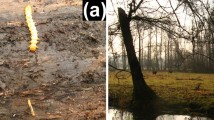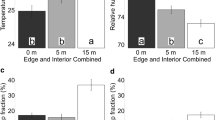Summary
Standing loblolly pines in southeastern North America are colonized by four sympatric species of bark beetles: Dendroctonus frontalis (Zimm.), Ips calligraphus (Germ.), I. grandicollis (Eichh.) and I. avulsus (Eichh.). The beetles compete for the limited amount of phloem tissue used as a site for reproduction. Using indices of niche breadth and niche overlap determined from the surface areas attacked, the interaction of colonizing beetle species in partitioning resources in entire trees and within each sample level was examined. The broadest niche breadth was exhibited by I. avulsus, while I. grandicollis had the narrowest. D. frontalis dominated the lower bole and overlapped primarily with I. calligraphus. The upper bole was similarly dominated by I. avulsus, which overlapped only slightly with D. frontalis, but overlapped extensively with I. calligraphus. Within tree species diversity was highest in the mid-bole sections and declined progressively toward the stump and top. Increasing species diversity showed a strong positive correlation with increasing mean niche overlap.
Similar content being viewed by others
References
Baker WL (1972) Eastern forest inseets. USDA Forest Service Misc. Publications No. 1175.
Barras SJ (1970) Antagonism between Dendroctonus frontalis and the fungus Ceratocystis minor. Ann Ent Soc of Amer 63:1187–1190
Berryman AA (1974) Dynamics of bark beetle populations: towards a general productivity model. Env Ent 3:579–585
Birch MC, Švihra P, Paine TD, Miller JC (1980) Olfactory discrimation among four sympatric species of bark beetles: a mechanism of resource partitioning. J Chem Ecol 6:395–414
Brown JH (1975) Geographical ecology of desert rodents. In: Ecology and evolution of communities ML Cody and JM Diamond (eds), Belknap Press of Harvard University Press, Cambridge p 315–341
Cody ML (1968) On the methods of resource division in grassland bird communities. Amer Nat 102:107–144
Colwell RK, Fuentes ER (1975) Experimental studies of the niche. Ann Rev Ecol and Syst 6:281–310
Colwell RK, Futuyma DJ (1971) On the measurement of niche breadth and overlap. Ecology 52:567–576
Coulson RN, Mayyasi AM, Foltz JL, Hain FP, Martin WC (1976) Resource utilization by the southern pine beetle, Dendroctonus frontalis (Coleoptera: Scolytidae). Can Ent 108:353–362
Denno RF, Cothran WR (1975) Niche relationships of a guild of necrophagous flies. Ann Ent Soc of Amer 68:741–754
Dudley CO (1971) A sampling design for the egg and first instar larval populations of the western pine beetle, Dendroctonus brevicomis (Coleoptera: Scolytidae). Can Ent 103:1291–1313
Graham SA, Knight FB (1965) Principles of forest entomology. McGraw-Hill New York
Hanson SR (1978) Resource utilization and coexistence of three species of Pogonomyrmex ants in an upper sonoran grassland community. Oecologia (Berl.) 35:109–117
Horn HS (1966) Measurement of “overlap” in comparative ecological studies. Amer Nat 160:419–424
Hutchinson GE (1958) Concluding Remarks. Cold Springs Harbor Symp Quant Biol 22:415–427
Levins R (1968) Evolution in changing environments: some theoretical explorations. Princeton University Press Princeton
Mathre PE (1964) Pathogenicity of Ceratocystis ips and Certocystis minor to Pinus ponderosa. Contrib. Boyce Thompson Inst 22:363–388
Mayyasi AM, Coulson RN, Foltz JL, Hain FP, Martin WC (1976) Functional description of with-in tree larval and progeny adult populations of Dendroctonus frontalis (Coleoptera: Scolytidae). Can Ent 108:363–373
McCloskey RT (1976) Community structure in sympatric rodents. Ecology 57:728–739
McMullen LH, Atkins MD (1961) Intraspecific competition as a factor in the natural control of the douglas-fir beetle. For Sci 7:197–203
Pianka ER (1969) Sympatry of desert lizards (Ctenotus) in western Australia. Ecology 50:1012–1030
Pianka ER (1975) Niche relations of desert lizards. In: Ecology and evolution of communities ML Cody and JM Diamond (eds), Belknap Press of Harvard University Press Cambridge p 294–314
Pielou EC (1972) Niche width and niche overlap: a method for measuring them. Ecology 53:687–692
Pielou EC (1975) Ecological diversity. John Wiley and Sons New York
Price PW (1971) Niche breadth and dominance of parasitic insects sharing the same host species. Ecology 52:589–597
Price PW (1975) Insect Ecology. John Wiley and Sons New York
Pulley PE, Foltz JL, Mayyasi AM, Coulson RN, Martin WC (1977) Sampling procedures for within tree attacking adult populations of the southern pine beetle, Dendroctonus frontalis (Coleoptera: Scolytidae). Can Ent 109:39–48
Rathcke BJ (1976) Competition and coexistence within a guild of herbiverous insects. Ecology 57:76–87
Schoener TW (1974) Resource partitioning in ecological communities. Science 185:27–39
Shannon CE, Weaver W (1963) The mathematical theory of communication. Urbana: University of Illinois Press
Southwood TRE (1968) Ecological methods with particular reference to the study of insect populations. Methuen and Co. London
Struble GR (1966) California five spined Ips USDA Forest Service. Forest Pest Leaflet 102
Švihra P, Paine TD, Birch MC (1980) Interspecific olfactory communications in southern pine beetles. Naturwissenschaften 67:518–519
Vandermeer JH (1972) Niche theory. Ann Rev Ecol and Syst 3:107–132
Vité JP, Gara RI, von Scheller DH (1964) Field observations on the response to attractants of bark beetles infesting soutehrn pines. Cont from Boyce Thomspon Inst 22:461–470
Vité JP, Ohloff PG, Billings RF (1978) Pheromonal chirality and integrity of aggregation response in southern species of the bark beetle Ips sp. Nature 272:818–819
Whitham TG (1978) Habitat selection by Pemphigus aphids in response to resource limitation and competition. Ecology 59: 1164–1176
Yearian WC, Gauger RJ, Wilkinson RC (1972) Effects of the blue stain fungus, Ceratocystis ips on the development of Ips bark beetles in pine bolts. Ann Ent Soc Amer 65:481–487
Author information
Authors and Affiliations
Rights and permissions
About this article
Cite this article
Paine, T.D., Birch, M.C. & Švihra, P. Niche breadth and resource partitioning by four sympatric species of bark beetles (Coleoptera: Scolytidae). Oecologia 48, 1–6 (1981). https://doi.org/10.1007/BF00346980
Received:
Issue Date:
DOI: https://doi.org/10.1007/BF00346980




